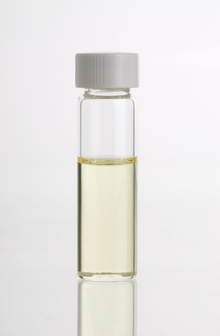薰衣草油

薰衣草油(英语:Lavender oil,CAS号:8000-28-0)是通过蒸馏某些薰衣草品种的花穗获得的精油。不同的品种提取出的薰衣草油有着不同的香气:提取自狭叶薰衣草(又名真薰衣草、英国薰衣草)的薰衣草油(lavender flower oil)有着清甜的花香,提取自宽叶薰衣草(又名穗状薰衣草、穗花薰衣草)的穗状薰衣草油(lavender spike oil)在清香中带有清凉的草药香,宽窄叶杂交薰衣草(又名醒目薰衣草[1])的精油香气则介于两者之间。[2][3]
与所有精油一样,薰衣草油不是纯净的单一化合物,而是复杂的植物性化合物的混合物,精油成分也因薰衣草的品种而异。[4]狭叶薰衣草精油的主要成分包括乙酸芳樟醇、芳樟醇,而穗状薰衣草油的主要成分包括芳樟醇、桉叶油醇和樟脑。[4]
生产[编辑]
薰衣草油是通过水蒸气蒸馏法生产的。[5][6]这种方法减少了极性化合物的损失,与其他方法相比能产生更多的精油。[7]薰衣草花的收获期通常在六月下旬至八月之间。[8]剪下的薰衣草花序被压入薰衣草蒸馏器中,水蒸汽从蒸馏器底部进入加热薰衣草。[5]油腺在加热过程中破裂,释放出的薰衣草油汽化与水蒸汽一起上升,在上方的冷管上凝结成液体,被收集到储罐中。[5]由于水和薰衣草油有着不同的极性和密度,两者不互溶,会在储罐中分层,将水从管道排出,即得到薰衣草油。[5][9]
薰衣草油在世界各地都有生产,其中保加利亚、法国和中国的产量领先。[10][11]
用途[编辑]
薰衣草油被用于香水、芳香疗法和皮肤涂抹,[12]但这些用法没有临床益处。[13]薰衣草油用于按摩疗法,通过直接接触皮肤使人放松,但可能会发生过敏反应。[13]目前没有充分的证据支持使用薰衣草油治疗失智症。[14]
2021年的一项荟萃分析包括五项针对焦虑症患者的研究,这五项研究均由所用薰衣草油胶囊的制造商资助,其中四项研究是由荟萃分析的一位作者进行,[15] 不清楚它们是否是盲法试验。 [16]这项分析显示,每天口服80毫克薰衣草油与汉密尔顿焦虑评定量表上的焦虑评分降低相关。[15]根据国家补充与替代医学中心的说法,由于这些研究的局限性,口服薰衣草油治疗焦虑症的有效性仍不确定。[13]
在蒸馏松节油普及之前,穗状薰衣草油曾被用作油画的溶剂。[17]
可能的不良影响[编辑]
尽管人们普遍认为薰衣草油对其预期用途是安全的,[18]但它是一种潜在的内分泌干扰物,持续接触可能会影响女孩和男孩的乳房发育。[19]
包括薰衣草油在内的许多精油,如果服用都有毒性。[20][21]一般来说,服用5毫升的稀释精油可能会导致成人中毒,2-3毫升可能会导致儿童中毒。[22] 2014-2018年,新南威尔士州报告了271起薰衣草油中毒病例,占所有精油中毒病例的6.1%,中毒者大多数是儿童。[21]
薰衣草油的主要有毒成分是乙酸芳樟酯和芳樟醇。[20][23]
摄入薰衣草油中毒的症状包括视力模糊、呼吸困难、喉咙灼痛、眼睛灼伤、神志不清、意识水平下降、腹泻、胃痛、呕吐和皮疹。[20]局部涂抹薰衣草油可能会引起接触性皮炎。[22]
摄入的薰衣草油可能会与处方药发生相互作用,包括抗凝剂、他汀类药物和抗癫痫药物。[24]
化学成分[编辑]
薰衣草油的植物性化合物成分因品种而异,主要由单萜和倍半萜醇组成。[24]主要是芳樟醇(20-35%)和乙酸芳樟酯(30-55%),并有中等水平的乙酸薰衣草酯、4-松油醇、薰衣草醇、 桉叶油醇、樟脑、柠烯和单宁。[24]薰衣草油通常含有100多种化合物,尽管其中许多化合物的浓度可以忽略不计。[24][25]
| 类 | 成分 | 狭叶薰衣草 | 宽叶薰衣草 |
|---|---|---|---|
| 萜烯/单萜醇 | 芳樟醇 |
28.92 % | 49.47 % |
| α-松油醇 | 0.90% | 1.08% | |
| γ-松油醇 | 0.09% | ||
| 冰片 | 1.43% | ||
| 异冰片 | 0.82% | ||
| 4-松油醇 | 4.32% | ||
| 橙花醇 | 0.20% | ||
| 薰衣草醇 | 0.78% | ||
| 萜烯/萜烯酯 |  乙酸芳樟酯 |
32.98 % | |
| 乙酸香叶酯 | 0.60% | ||
| 乙酸橙花酯 | 0.32% | ||
| 乙酸蘑菇酯 | 0.65% | ||
| 乙酸薰衣草酯 | 4.52% | ||
| 萜烯/单萜 | 月桂烯 | 0.46% | 0.41% |
| α-蒎烯 | 0.54% | ||
| β-蒎烯 | 0.33% | ||
| 莰烯 | 0.30% | ||
| ( E )-β-罗勒烯 | 3.09% | ||
| ( Z )-β-罗勒烯 | 4.44% | ||
| β-水芹烯 | 0.12% | ||
| 萜烯/萜类氧化物 |  桉叶油醇 |
25.91 % | |
| 萜烯/倍半萜烯 | β-石竹烯 | 4.62% | 2.10% |
| β-金合欢烯 | 2.73% | ||
| β-月桂烯 | 0.27% | ||
| α-葎草烯 | 0.28% | ||
| 酮类 |  樟脑 |
0.85% | 13:00 % |
| 3-辛酮 | 0.72% | ||
 隐品酮(Cryptone) |
0.35% |
参考[编辑]
- ^ 盐屋绍子. 精油大全. 江西科学技术出版社. 2019. ISBN 9787539069524.
- ^ 国际化妆品原料标准中文名称目录(2010年版)
- ^ 向杰; 程锴. 香精香料应用技术基础. 化学工业出版社. 2021. ISBN 9787122391810.
- ^ 4.0 4.1 4.2 Marincaş, Olivian; Feher, Ioana. A new cost-effective approach for lavender essential oils quality assessment. Industrial Crops and Products. 2018-12-01, 125: 241–247. ISSN 0926-6690. S2CID 104553013. doi:10.1016/j.indcrop.2018.09.010 (英语).
- ^ 5.0 5.1 5.2 5.3 Lis-Balchin, Maria. Lavender: The Genus Lavandula. CRC Press. August 2002. ISBN 978-0-203-21652-1 (英语).
- ^ Health (U.S.), National Institute of. Digest of Comments on The Pharmacopœia of the United States of America and on the National Formulary for the Calendar Year ... 1905-1922. U.S. Government Printing Office. 1919 (英语).
- ^ Masango P. Cleaner production of essential oils by steam distillation. Journal of Cleaner Production. 2005-06-01, 13 (8): 833–839. ISSN 0959-6526. doi:10.1016/j.jclepro.2004.02.039.
- ^ Simmons, Adelma Grenier. Country wreaths from Caprilands: the legend, lore, and design of traditional herbal wreaths. Rodale Press. 1989. ISBN 978-0-87857-792-7 (英语).
- ^ Chanamai R, Horn G, McClements DJ. Influence of oil polarity on droplet growth in oil-in-water emulsions stabilized by a weakly adsorbing biopolymer or a nonionic surfactant. Journal of Colloid and Interface Science. March 2002, 247 (1): 167–76. Bibcode:2002JCIS..247..167C. PMID 16290453. doi:10.1006/jcis.2001.8110.
- ^ Mihala, Lorelei. Bulgarian lavender: The sweet smell of success. BBC News. 2020-07-30 [2020-08-03]. (原始内容存档于2021-03-11) (英国英语).
- ^ Giray, Handan. An Analysis of World Lavender Oil Markets and Lessons for Turkey. Journal of Essential Oil-bearing Plants. November 2018, 21 (6): 1612–1623. S2CID 107300743. doi:10.1080/0972060X.2019.1574612.
- ^ Groom N. The New Perfume Handbook 2nd. Blackie Academic & Professional. 1997: 184–186. ISBN 978-0-7514-0403-6.
- ^ 13.0 13.1 13.2 Lavender. National Center for Complementary and Integrative Health, US National Institutes of Health. 1 August 2020 [1 July 2022]. (原始内容存档于2023-10-01)."Lavender" (页面存档备份,存于互联网档案馆). National Center for Complementary and Integrative Health, US National Institutes of Health. 1 August 2020. Retrieved 1 July 2022.
- ^ Ball EL, Owen-Booth B, Gray A, Shenkin SD, Hewitt J, McCleery J. Aromatherapy for dementia. Cochrane Database of Systematic Reviews (Meta-analysis). August 2020, 2020 (8): CD003150. PMC 7437395
 . PMID 32813272. doi:10.1002/14651858.CD003150.pub3.
. PMID 32813272. doi:10.1002/14651858.CD003150.pub3.
- ^ 15.0 15.1 von Känel, Roland; Kasper, Siegfried; Bondolfi, Guido; et al. Therapeutic effects of Silexan on somatic symptoms and physical health in patients with anxiety disorders: A meta-analysis. Brain and Behavior. 2021-04-11, 11 (4): e01997. ISSN 2162-3279. PMC 8035468
 . PMID 33638614. doi:10.1002/brb3.1997.
. PMID 33638614. doi:10.1002/brb3.1997.
- ^ Generoso, Marcelo B.; Soares, Amanda; Taiar, Ivan T.; Cordeiro, Quirino; Shiozawa, Pedro. Lavender Oil Preparation (Silexan) for Treating Anxiety. Journal of Clinical Psychopharmacology. 2017, 37 (1): 115–117. ISSN 1533-712X. PMID 27861196. S2CID 42697028. doi:10.1097/jcp.0000000000000615.
- ^ The Grove encyclopedia of materials and techniques in art. Oxford University Press. 2008: 605–606. ISBN 978-0-19-531391-8.
- ^ Sec. 182.20 Essential oils, oleoresins (solvent-free), and natural extractives (including distillates). FDA. [24 March 2022]. (原始内容存档于2019-05-01).
- ^ Endocrine disruptors. National Institute of Environmental Health Sciences, US National Institutes of Health. 2 June 2023 [5 July 2023]. (原始内容存档于2020-06-11) (英语).
- ^ 20.0 20.1 20.2 Lavender oil. MedlinePlus, National Library of Medicine, US National Institutes of Health. 13 November 2021 [9 January 2020]. (原始内容存档于2023-04-23).
Poisonous ingredient: It is mainly the linalyl acetate and linalool in lavender oil that are poisonous.
- ^ 21.0 21.1 Lee KA, Harnett JE, Cairns R. Essential oil exposures in Australia: analysis of cases reported to the NSW Poisons Information Centre. The Medical Journal of Australia. November 2019, 212 (3): 132–133. PMID 31709543. S2CID 207940224. doi:10.5694/mja2.50403
 .
. We found that essential oil exposures are frequent in Australia, and that more than half involve children. ... severe toxicity can be caused by as little as 5 mL
- ^ 22.0 22.1 Essential oil poisoning. Royal Children's Hospital, Melbourne, Australia. July 2021 [2023-09-14]. (原始内容存档于2023-03-21).
Volumes of 5-15 mL are likely to cause toxicity in adults
"Essential oil poisoning" (页面存档备份,存于互联网档案馆). Royal Children's Hospital, Melbourne, Australia. July 2021.Volumes of 5-15 mL are likely to cause toxicity in adults
- ^ Elshafie HS, Camele I. An overview of the biological effects of some Mediterranean essential oils on human health. BioMed Research International. 5 November 2017, 2017: 9268468. PMC 5694587
 . PMID 29230418. doi:10.1155/2017/9268468
. PMID 29230418. doi:10.1155/2017/9268468  .
.
- ^ 24.0 24.1 24.2 24.3 Lavender. Drugs.com. 22 October 2021 [25 May 2022]. (原始内容存档于2021-08-19)."Lavender" (页面存档备份,存于互联网档案馆). Drugs.com. 22 October 2021. Retrieved 25 May 2022.
- ^ Shellie R, Mondello L, Marriott P, Dugo G. Characterisation of lavender essential oils by using gas chromatography-mass spectrometry with correlation of linear retention indices and comparison with comprehensive two-dimensional gas chromatography. Journal of Chromatography A. September 2002, 970 (1–2): 225–34. PMID 12350096. doi:10.1016/S0021-9673(02)00653-2.
